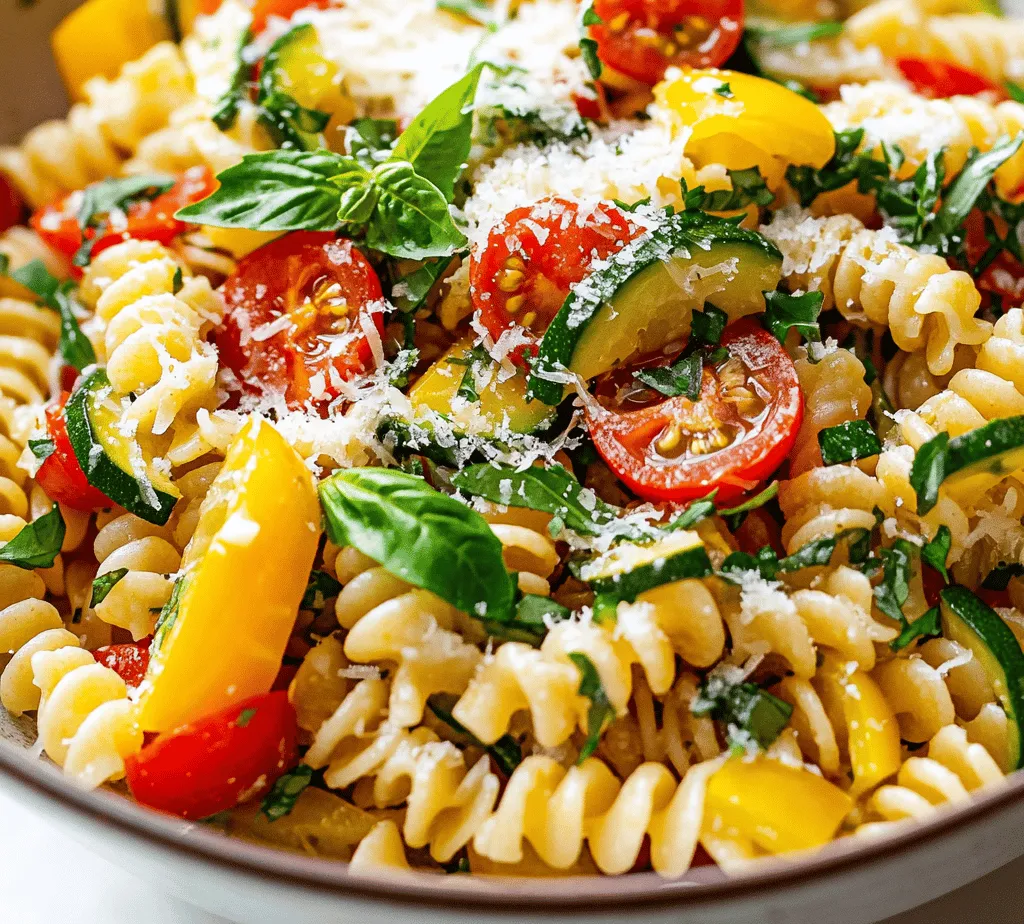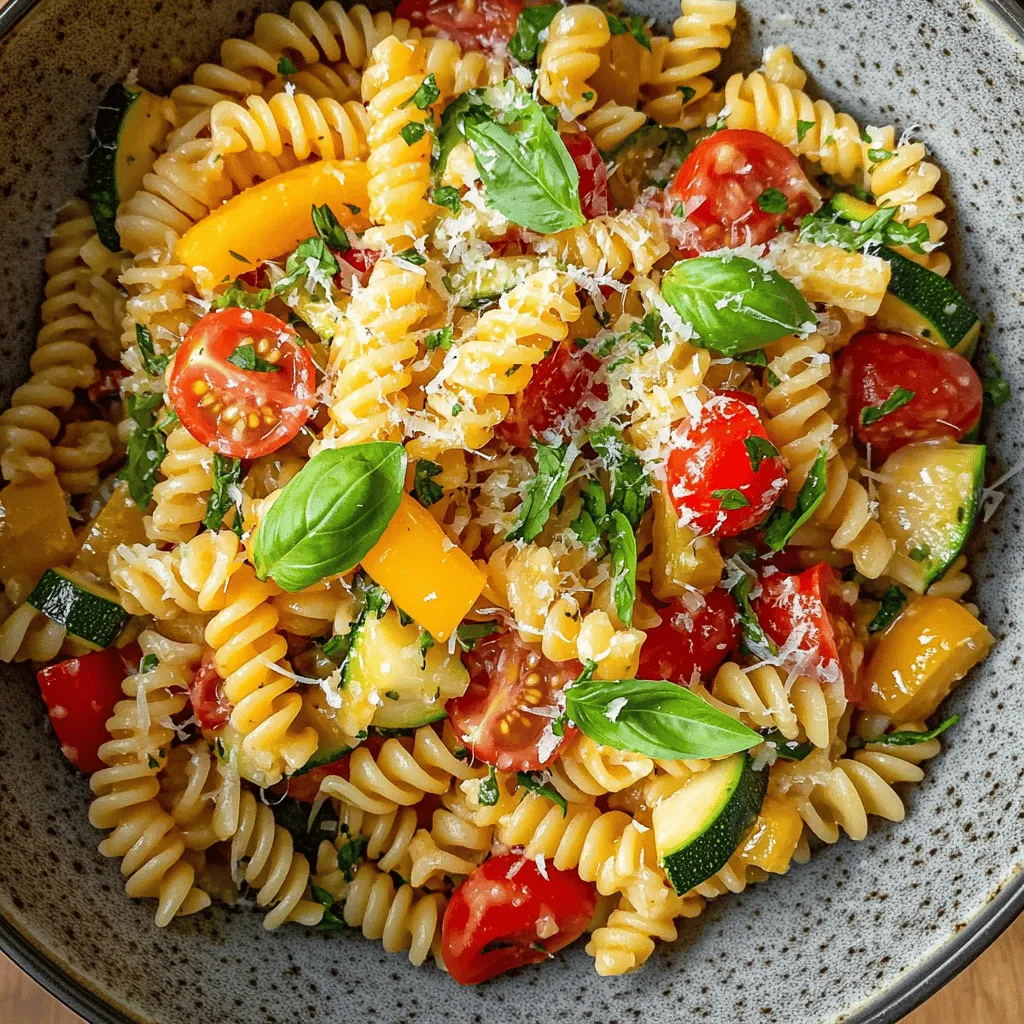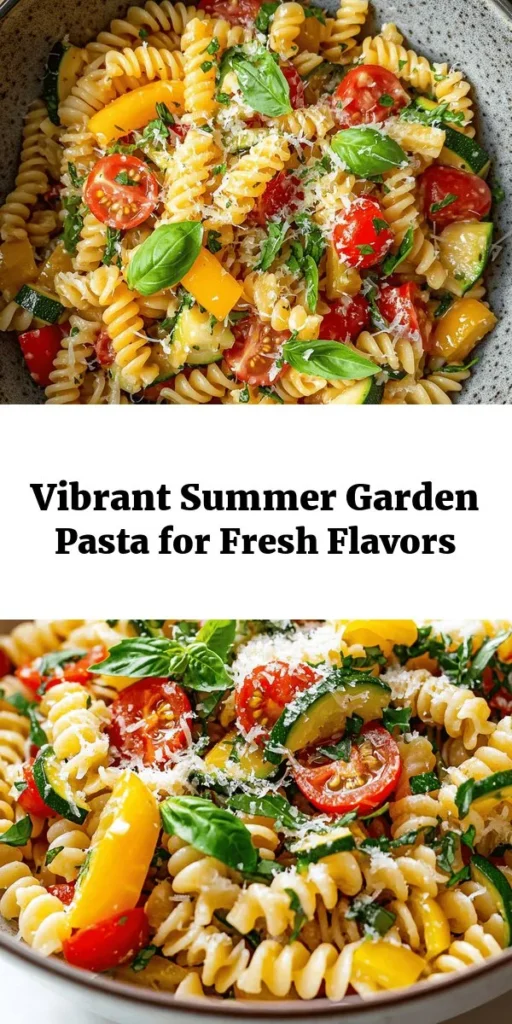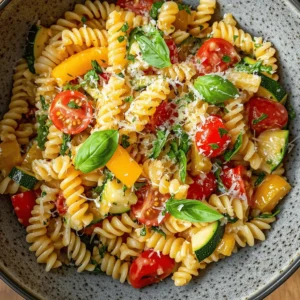Introduction
In the warm embrace of summer, when gardens flourish and farmers’ markets overflow with fresh produce, there’s nothing quite like a light and vibrant pasta dish that celebrates the season’s bounty. The Summer Garden Pasta Bliss is a perfect recipe to bring the flavors of summer to your table, featuring a colorful medley of vegetables tossed with perfectly cooked pasta. This dish not only captures the essence of the season but also embodies the philosophy of seasonal cooking, where the fresher the ingredients, the better the flavor.
Imagine twirling your fork through spirals of pasta, enveloped in a fragrant olive oil sauce, punctuated by the crunch of garden-fresh vegetables. It’s a dish that is not only easy to prepare but also incredibly satisfying, making it an ideal choice for lazy summer evenings or gatherings with friends. This article will guide you through the delightful process of creating this dish, including ingredient details, step-by-step instructions, and tips for enhancing your culinary experience.
Understanding Summer Garden Pasta Bliss
The Significance of Seasonal Ingredients
Incorporating seasonal ingredients into your meals is more than just a culinary trend; it’s a philosophy that encourages consumers to connect with the natural rhythms of the earth. When you choose ingredients that are in season, you’re not only supporting local farmers and reducing the carbon footprint associated with transporting food, but you’re also ensuring that your meals are packed with flavor and nutrients.
The Importance of Using Fresh Vegetables
Fresh vegetables are the cornerstone of the Summer Garden Pasta Bliss. During the summer months, vegetables are at their peak, bursting with flavor and nutrients. For example, sun-ripened tomatoes offer a sweetness that can’t be matched by out-of-season varieties. Likewise, zucchini, bell peppers, and corn are tender and juicy, providing a delightful contrast to the pasta. The idea is to let these ingredients shine without overwhelming them with heavy sauces or spices.
How Seasonal Cooking Enhances Flavor and Nutrition
Cooking with seasonal ingredients enhances not only the flavor of your dishes but also their nutritional value. Seasonal produce is often harvested at its peak ripeness, meaning it retains more of its vitamins and minerals. Additionally, these ingredients tend to be more affordable, as they are abundant during their growing season. This means you can create a delicious, healthy meal without breaking the bank.
By embracing seasonal cooking in your kitchen, you can foster a deeper appreciation for the cycles of nature while enjoying the freshest flavors that summer has to offer.
Essential Ingredients for Summer Garden Pasta Bliss
To create the ultimate Summer Garden Pasta Bliss, it’s essential to focus on the ingredients that will make this dish shine. Here’s a closer look at what you’ll need:
Pasta Choice: Fusilli vs. Rotini
When it comes to selecting the right pasta for this dish, fusilli and rotini are both excellent options. Their spiral shapes are perfect for holding onto the sauce and bits of vegetables, ensuring every bite is full of flavor. Fusilli, with its tighter twists, can capture more sauce, while rotini offers a slightly looser spiral that provides a satisfying texture. Ultimately, the choice comes down to personal preference, but either option will complement the vibrant ingredients beautifully.
The Role of Olive Oil in Flavor and Health
Olive oil is a key player in this recipe, serving as the base for the sauce that coats the pasta and vegetables. Not only does it enhance the flavor profile of the dish, but it also offers numerous health benefits. Rich in monounsaturated fats and antioxidants, olive oil can promote heart health and reduce inflammation. When selecting olive oil, opt for extra virgin varieties, which are cold-pressed and retain more of the natural flavors and nutrients.
Overview of Vegetables
The vegetable medley in this dish is crucial to its success. Here are the star ingredients that will bring your Summer Garden Pasta Bliss to life:
– Onion: Adds depth and sweetness when sautéed, providing a flavorful foundation for the dish.
– Garlic: Infuses the dish with an aromatic punch, enhancing the overall flavor.
– Bell Pepper: Offers a crisp texture and a subtle sweetness; choose a mix of colors for visual appeal.
– Zucchini: Adds a tender, slightly nutty flavor that complements the other vegetables.
– Cherry Tomatoes: Burst with sweetness and juiciness, they bring a refreshing contrast to the dish.
– Corn: Adds a delightful crunch and a touch of sweetness, perfect for summer.
The Impact of Fresh Herbs
Fresh herbs are the finishing touch that elevates this dish. Basil, in particular, is a classic addition that complements the flavors of summer. Its fragrant leaves add a peppery freshness that brightens the entire dish. When using fresh herbs, try to add them at the end of cooking to preserve their vibrant flavor and aroma.
The Zest and Juice of Lemon for Brightness
Incorporating the zest and juice of a lemon is essential for adding brightness and acidity to the dish. The citrus notes help to balance the richness of the olive oil and cheese, while also enhancing the flavors of the vegetables. A squeeze of fresh lemon juice just before serving can elevate the dish, making it taste even more refreshing and lively.
Parmesan Cheese: A Classic Addition for Richness
Finally, no pasta dish is complete without a sprinkle of grated Parmesan cheese. This classic ingredient adds a nutty, salty richness that complements the vegetables beautifully. For the best results, opt for freshly grated Parmesan, as it melts better and has a more intense flavor compared to pre-grated varieties.
Preparing the Pasta
Now that you have a clear understanding of the ingredients, it’s time to dive into the cooking process. Here’s a step-by-step guide to cooking the pasta perfectly, ensuring it’s al dente and ready to absorb all the delicious flavors of the dish.
How to Choose the Right Pot and Water Ratio
Choosing the right pot is crucial for cooking pasta. A large pot allows the pasta to move freely as it cooks. For every pound of pasta, use at least four to six quarts of water. This prevents the pasta from becoming sticky and ensures even cooking.
Importance of Salting the Water
Before adding the pasta, be sure to generously salt the water. This step is vital as it enhances the flavor of the pasta itself. The water should taste like the sea—this is the only opportunity you have to season the pasta from the inside out.
Tips for Cooking Pasta Al Dente
Cooking pasta al dente, or “to the tooth,” refers to the ideal texture where it’s firm to the bite but cooked through. Follow these tips to achieve perfect pasta:
1. Timing: Check the package instructions for cooking times, but start tasting the pasta one to two minutes before the recommended time to ensure it doesn’t overcook.
2. Stirring: Stir the pasta occasionally to prevent it from sticking together.
3. Reserving Pasta Water: Before draining, reserve a cup of the pasta cooking water. This starchy water can be used later to adjust the sauce’s consistency and help the sauce cling to the pasta.
Proper Techniques for Draining and Reserving Pasta Water
When the pasta reaches the al dente stage, carefully drain it in a colander. Be cautious not to rinse the pasta, as rinsing removes the starch that helps the sauce adhere. If you’ve reserved pasta water, set it aside; it will come in handy when you combine the pasta with the sautéed vegetables.
Sautéing the Vegetables
With the pasta cooking, it’s time to focus on the vegetables that will elevate your Summer Garden Pasta Bliss. Sautéing is a technique that enhances the flavors of the vegetables while retaining their crispness.
Choosing the Right Skillet and Heat
A large skillet or sauté pan is ideal for this step, allowing you to cook the vegetables evenly without overcrowding. Heat the skillet over medium heat and add a generous drizzle of olive oil. This oil will not only prevent sticking but also infuse the vegetables with flavor as they cook.
Sautéing Onions and Garlic: Timing for Maximum Aroma
Begin by adding the chopped onions to the hot skillet. Sauté them for about 2-3 minutes until they become translucent and fragrant. Next, add the minced garlic, stirring it in for an additional 30 seconds. Be cautious not to burn the garlic, as it can turn bitter if overcooked. This initial step builds the aromatic base for your dish.
As the onions and garlic soften, their natural sweetness will be released, creating a flavorful foundation that enhances the overall taste of the pasta.
(Continue with the detailed steps for sautéing the remaining vegetables and combining them with the pasta, as well as additional tips for achieving the best results in the next part of the article.)




